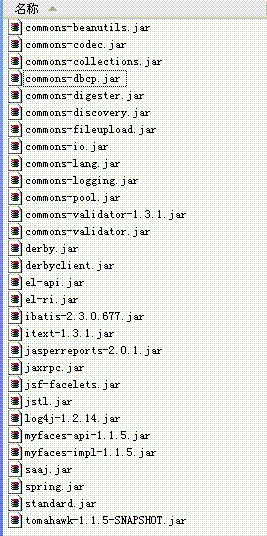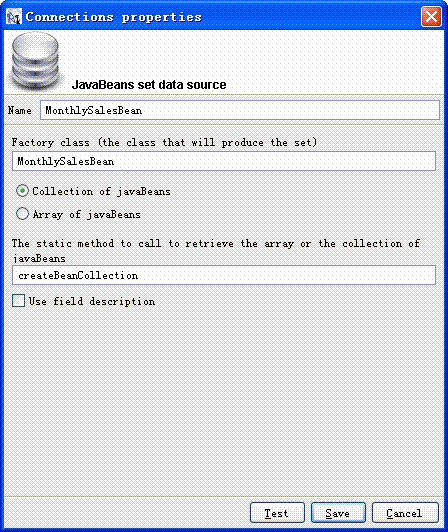应该IT168写的专稿:
http://publish.itpub.net/j/2008-01-24/200801241020641.shtml
使用JasperReport与iBATIS开发Web报表
JasperReport是一种采用纯Java实现的快速且非常流行的生成报表的类库。而对于任何的报表方案,取得数据并传递给报表引擎是其中最重要且最值得关心的方面。但遗憾的是,在这方面JasperReport本身似乎有一定的不足。而如今的很多Java应用程序,采用数据获取框架来进行数据的匹配与动态生成SQL。例如iBATIS数据映射框架。当然,如果只是使用JasperReport获取数据及管理数据的默认机制的话,不足以与现成的数据框架进行很好的平衡。但可喜的是,可以通过使用传递给JasperReport一个数据库的连接进行代替,当然这种连接可以通过使用XML进行非常方便的管理与配置。
源代码下载:http://cid-7b377ace522ff6c7.skydrive.live.com/self.aspx/iBatisJasper/iBatisJasper.rar
一、准备工作
与Hibernate类似,iBATIS也是一个ORM解决方案,不同的是两者各有侧重。Hibernate提供了Java对象到数据库表之间的直接映射,开发者无需直接涉及数据库操作的实现细节,实现了一站式的ORM解决方案。而iBATIS则采取了另一种方式,即提供Java对象到SQL(面向参数和结果集)的映射实现,实际的数据库操作需要通过手动编写SQL实现。
iBATIS是又一个O/R Mapping解决方案,j2ee的O/R方案真是多,和Hibernate相比,iBATIS最大的特点就是小巧,上手很快。如果你不需要太多复杂的功能,iBATIS是能满足你的要求又足够灵活的最简单的解决方案。在本文的示例中,采用Spring+JSF+iBATIS的模式进行示例的开发。所使用的lib如下图所示:

图1.所使用的jar包
二、在iReport中可视化定制模板
定制报表格式有二种方式,一种就是写jrxml文件,其实就是xml文件,只不过是后缀名不一样罢了。另一种方式更直接,就是生成一个JasperDesign类的实例,在japsperDesign中自己定义模板。jrxml文件也是通过一个JRXmlLoad加载过来,转成JasperDesign类的实例。也就是说写jrxml文件还需要进行解析,加载。现实中我们使用的报表一般格式比较固定,因而可以通过先使用iReport工具生成模板,再加载解析的方式。这种方式简单,而且可见性强。
iReport做为一个优秀的报表设计器,有着功能非常强大的特性。作为开源的Java程序,不但有适合于Windows安装的应用程序,同时,还提供完全开放的源代码,可供参考及原理分析。在本文中,主要通过图形界面中的模板设计,以及与数据库的连接等一系列的操作,来介绍如何定制一定要求的报表模板。
通过iReport可初见化的图形界面,可以设计出各种各样的简单或复杂的报表。通过iReport的这种可视化界面设计,可以为JasperReport提供优秀的报表模板,而无须去理解或是掌握那些复杂的XML语法。如此则可以Web报表开发节省大量的开发时间。
在进行iReport模板设计之前,需要编写JavaBean类:MonthlySalesBean.java,代码如下:
 import java.math.BigDecimal;
import java.math.BigDecimal;
 import java.util.ArrayList;
import java.util.ArrayList;
 import java.util.List;
import java.util.List;



 public class MonthlySalesBean
public class MonthlySalesBean  {
{

 private int employeeID;;
private int employeeID;;
 private String last = null;
private String last = null;
 private String first = null;
private String first = null;
 private BigDecimal total = null;
private BigDecimal total = null;
 private List sales = null;
private List sales = null;
 private LatestSale latestSale = null;
private LatestSale latestSale = null;


 public static List createBeanCollection ()
public static List createBeanCollection ()  {
{
 List list = new ArrayList ();
List list = new ArrayList ();

 MonthlySalesBean msb = new MonthlySalesBean ();
MonthlySalesBean msb = new MonthlySalesBean ();
 msb.setEmployeeID(1);
msb.setEmployeeID(1);
 msb.setFirst("John");
msb.setFirst("John");
 msb.setLast("Doe");
msb.setLast("Doe");
 msb.setTotal(new BigDecimal ("1600.50"));
msb.setTotal(new BigDecimal ("1600.50"));

 LatestSale ls = new LatestSale ();
LatestSale ls = new LatestSale ();
 ls.setAmount(new BigDecimal ("32.21"));
ls.setAmount(new BigDecimal ("32.21"));
 msb.setLatestSale(ls);
msb.setLatestSale(ls);

 list.add(msb);
list.add(msb);

 return list;
return list;
 }
}

 public int getEmployeeID()
public int getEmployeeID()  {
{
 return employeeID;
return employeeID;
 }
}

 public void setEmployeeID(int employeeID)
public void setEmployeeID(int employeeID)  {
{
 this.employeeID = employeeID;
this.employeeID = employeeID;
 }
}

 public String getFirst()
public String getFirst()  {
{
 return first;
return first;
 }
}

 public void setFirst(String first)
public void setFirst(String first)  {
{
 this.first = first;
this.first = first;
 }
}

 public String getLast()
public String getLast()  {
{
 return last;
return last;
 }
}

 public void setLast(String last)
public void setLast(String last)  {
{
 this.last = last;
this.last = last;
 }
}

 public BigDecimal getTotal()
public BigDecimal getTotal()  {
{
 return total;
return total;
 }
}

 public void setTotal(BigDecimal total)
public void setTotal(BigDecimal total)  {
{
 this.total = total;
this.total = total;
 }
}

 public List getSales()
public List getSales()  {
{
 return sales;
return sales;
 }
}

 public void setSales(List sales)
public void setSales(List sales)  {
{
 this.sales = sales;
this.sales = sales;
 }
}

 public LatestSale getLatestSale()
public LatestSale getLatestSale()  {
{
 return latestSale;
return latestSale;
 }
}

 public void setLatestSale(LatestSale latestSale)
public void setLatestSale(LatestSale latestSale)  {
{
 this.latestSale = latestSale;
this.latestSale = latestSale;
 }
}
 }
}

将上面的类打成一个jar包,并置于classpath目录下,则iReport可以进行访问。使用JavaBean做为数据源,为了在设计报表时能够看到数据,在程序中要为iReport提供一个静态方法,该方法返回上面定义JavaBean的一个结果集,这个静态方法可能在程序运行中并不是必须的,但是在iReport中它确实必须的,换句话说,这个静态方法是专门为iReport量身定做的,为了iReport在设计报表时能够调用这个静态方法返回相应的JavaBean结果集,以便设计的报表放在Java项目中之前就能像使用SQL数据库数据源一样可以浏览。在iReport中先进行数据源的连接配置,此处采用是JavaBeans set data source连接方式:

图2.在iReport进行数据源的连接
三、处理iBati返回数据
如果iBATIS没有采用JavaBean作为返回对象,则可以采用java.util.map作为数据的返回对象。采用java.util.Map对象,需要额外的一些步骤。下面的代码则说明了iBATIS的select语句返回的java.util.Map对象。Src/ iBATIS.xml:
 <?xml version="1.0" encoding="UTF-8"?>
<?xml version="1.0" encoding="UTF-8"?>
 <!DOCTYPE sqlMap PUBLIC "-//iBATIS.com//DTD SQL Map 1.0//EN"
<!DOCTYPE sqlMap PUBLIC "-//iBATIS.com//DTD SQL Map 1.0//EN"
 "http://iBATIS.apache.org/dtd/sql-map-2.dtd">
"http://iBATIS.apache.org/dtd/sql-map-2.dtd">
 <sqlMap>
<sqlMap>

 <select id="salesByListOfMapsSQL" resultClass="java.util.HashMap">
<select id="salesByListOfMapsSQL" resultClass="java.util.HashMap">
 SELECT
SELECT
 E.EMPLOYEE_ID "ID",
E.EMPLOYEE_ID "ID",
 E.FIRST_NAME "FIRST",
E.FIRST_NAME "FIRST",
 E.LAST_NAME "LAST",
E.LAST_NAME "LAST",
 MS.TOTAL_SALES "TOTAL",
MS.TOTAL_SALES "TOTAL",
 MS.LATEST_SALE
MS.LATEST_SALE
 FROM
FROM
 EMPLOYEE E,
EMPLOYEE E,
 MONTHLY_SALES MS
MONTHLY_SALES MS
 WHERE
WHERE
 E.EMPLOYEE_ID = MS.EMPLOYEE_ID
E.EMPLOYEE_ID = MS.EMPLOYEE_ID
 AND MS.MONTH = #value#
AND MS.MONTH = #value#
 </select>
</select>

 <resultMap id="searchResultList" class="MonthlySalesBean">
<resultMap id="searchResultList" class="MonthlySalesBean">
 <result property="employeeID" column="ID"/>
<result property="employeeID" column="ID"/>
 <result property="first" column="FIRST"/>
<result property="first" column="FIRST"/>
 <result property="last" column="LAST"/>
<result property="last" column="LAST"/>
 <result property="total" column="TOTAL"/>
<result property="total" column="TOTAL"/>
 <result property="latestSale.amount" column="LATEST_SALE"/>
<result property="latestSale.amount" column="LATEST_SALE"/>
 </resultMap>
</resultMap>

 <select id="salesByJavaBeansSQL" resultMap="searchResultList">
<select id="salesByJavaBeansSQL" resultMap="searchResultList">
 SELECT
SELECT
 E.EMPLOYEE_ID "ID",
E.EMPLOYEE_ID "ID",
 E.FIRST_NAME "FIRST",
E.FIRST_NAME "FIRST",
 E.LAST_NAME "LAST",
E.LAST_NAME "LAST",
 MS.TOTAL_SALES "TOTAL",
MS.TOTAL_SALES "TOTAL",
 MS.LATEST_SALE
MS.LATEST_SALE
 FROM
FROM
 EMPLOYEE E,
EMPLOYEE E,
 MONTHLY_SALES MS
MONTHLY_SALES MS
 WHERE
WHERE
 E.EMPLOYEE_ID = MS.EMPLOYEE_ID
E.EMPLOYEE_ID = MS.EMPLOYEE_ID
 AND MS.MONTH = #value#
AND MS.MONTH = #value#
 </select>
</select>
 </sqlMap>
</sqlMap>

上面的代码返回的对象即为map对象。请注意,map对象中的Key值直接来自于select语句,因此,像TO_CHAR(MS.TOTAL_SALES)这样的表达式在报表中不提倡使用。因此,比较人性化的为字段命名,是一件很值得的事情。因为map的key值是作为java.lang.Object类型来进行存储的,因此有必要对字段返回类型进行一下整理。
真正的数据填充类应该是ServiceLocatorBean.java类,其代码如下所示:
 import java.sql.Connection;
import java.sql.Connection;
 import java.sql.SQLException;
import java.sql.SQLException;
 import java.sql.Statement;
import java.sql.Statement;

 import javax.servlet.ServletContext;
import javax.servlet.ServletContext;

 import org.springframework.context.ApplicationContext;
import org.springframework.context.ApplicationContext;
 import org.springframework.web.context.support.WebApplicationContextUtils;
import org.springframework.web.context.support.WebApplicationContextUtils;


 public class ServiceLocatorBean implements ServiceLocatorIF
public class ServiceLocatorBean implements ServiceLocatorIF  {
{

 private static final long serialVersionUID = -7166271873610635886L;
private static final long serialVersionUID = -7166271873610635886L;

 //the Spring application context
//the Spring application context
 private ApplicationContext appContext;
private ApplicationContext appContext;

 DAO dao = null;
DAO dao = null;


 public ServiceLocatorBean()
public ServiceLocatorBean()  {
{


 try
try  {
{

 // get the spring context
// get the spring context
 ServletContext context = FacesUtils.getServletContext();
ServletContext context = FacesUtils.getServletContext();
 this.appContext = WebApplicationContextUtils.getRequiredWebApplicationContext(context);
this.appContext = WebApplicationContextUtils.getRequiredWebApplicationContext(context);

 // create instance of the business object
// create instance of the business object
 this.dao = (DAO) this.lookupService("dao");
this.dao = (DAO) this.lookupService("dao");

 Connection conn = this.dao.getSqlMapClient().getDataSource().getConnection();
Connection conn = this.dao.getSqlMapClient().getDataSource().getConnection();

 conn.setAutoCommit(false);
conn.setAutoCommit(false);


 /**//*
/**//*
 Creating a statement lets us issue commands against
Creating a statement lets us issue commands against
 the connection.
the connection.
 */
*/
 Statement s = conn.createStatement();
Statement s = conn.createStatement();

 // just in case old tables from prior run (after first run which
// just in case old tables from prior run (after first run which
 // will create the USER1 schema)
// will create the USER1 schema)

 try
try  {
{
 s.execute("drop table employee");
s.execute("drop table employee");
 s.execute("drop table monthly_sales");
s.execute("drop table monthly_sales");

 } catch (Exception ex)
} catch (Exception ex)  {
{
 // not to be concerned (at least in this example
// not to be concerned (at least in this example
 }
}


 /**//*
/**//*
 We create a table, add a few rows, and update one.
We create a table, add a few rows, and update one.
 */
*/
 s.execute("create table employee (employee_id int, first_name varchar(40), last_name varchar(40))");
s.execute("create table employee (employee_id int, first_name varchar(40), last_name varchar(40))");

 s.execute("insert into employee values (1,'sterning', 'chen')");
s.execute("insert into employee values (1,'sterning', 'chen')");
 s.execute("insert into employee values (2,'yuxuan', 'Wand')");
s.execute("insert into employee values (2,'yuxuan', 'Wand')");
 s.execute("insert into employee values (3,'Mickey', 'Li')");
s.execute("insert into employee values (3,'Mickey', 'Li')");

 s.execute("create table monthly_sales (employee_id int, total_sales numeric(16, 2), latest_sale numeric(8, 2), month int)");
s.execute("create table monthly_sales (employee_id int, total_sales numeric(16, 2), latest_sale numeric(8, 2), month int)");

 s.execute("insert into monthly_sales values (1, 1600.50, 32.50, 1)");
s.execute("insert into monthly_sales values (1, 1600.50, 32.50, 1)");
 s.execute("insert into monthly_sales values (2, 1544.20, 12.50, 1)");
s.execute("insert into monthly_sales values (2, 1544.20, 12.50, 1)");
 s.execute("insert into monthly_sales values (3, 18814.80, 78.65, 1)");
s.execute("insert into monthly_sales values (3, 18814.80, 78.65, 1)");

 s.execute("insert into monthly_sales values (1, 1450.50, 10.65, 2)");
s.execute("insert into monthly_sales values (1, 1450.50, 10.65, 2)");
 s.execute("insert into monthly_sales values (2, 2004.25, 52.10, 2)");
s.execute("insert into monthly_sales values (2, 2004.25, 52.10, 2)");
 s.execute("insert into monthly_sales values (3, 9819.00, 40.65, 2)");
s.execute("insert into monthly_sales values (3, 9819.00, 40.65, 2)");

 s.close();
s.close();
 conn.commit();
conn.commit();


 } catch (SQLException sqle)
} catch (SQLException sqle)  {
{
 // just means the tables already exist
// just means the tables already exist
 sqle.printStackTrace();
sqle.printStackTrace();

 } catch (Exception ex)
} catch (Exception ex)  {
{
 ex.printStackTrace();
ex.printStackTrace();
 }
}

 }
}


 public DAO getDao()
public DAO getDao()  {
{
 return this.dao;
return this.dao;
 }
}


 public Object lookupService(String serviceBeanName)
public Object lookupService(String serviceBeanName)  {
{
 return appContext.getBean(serviceBeanName);
return appContext.getBean(serviceBeanName);
 }
}

 }
}

四、将iBATIS数据填入JasperReport中
就通常而言,采用Java Bean作为iBATIS的返回对象,相比起java.util.Map对象来说,更加的方便与可行。很多的开发人员采用iBATIS的这种方式来进行数据的映射,同时,此方法还可以无缝的将iBATIS与JapserReport集成起来。
在JasperReport中,提供了一个JRDataSource的实现,从而开发人员可以通过此类来传递iBATIS的list对象给JasperReport模板。而JRBeanCollectionDataSource类使用JavaBean来构造,从而可以通过循环查找collection并获得相应的bean属性。如下的代码示例说明了如何在调用JasperReport引擎时实例化JRBeanCollectionDataSource对象。
 import java.io.File;
import java.io.File;
 import java.util.HashMap;
import java.util.HashMap;
 import java.util.List;
import java.util.List;

 import net.sf.jasperreports.engine.JRRuntimeException;
import net.sf.jasperreports.engine.JRRuntimeException;
 import net.sf.jasperreports.engine.JasperFillManager;
import net.sf.jasperreports.engine.JasperFillManager;
 import net.sf.jasperreports.engine.JasperPrint;
import net.sf.jasperreports.engine.JasperPrint;
 import net.sf.jasperreports.engine.JasperReport;
import net.sf.jasperreports.engine.JasperReport;
 import net.sf.jasperreports.engine.data.JRBeanCollectionDataSource;
import net.sf.jasperreports.engine.data.JRBeanCollectionDataSource;
 import net.sf.jasperreports.engine.util.JRLoader;
import net.sf.jasperreports.engine.util.JRLoader;



 public class SearchBean
public class SearchBean  {
{

 private final static String JAVA_BEAN_REPORT = "monthly_sales_java_beans.jasper";
private final static String JAVA_BEAN_REPORT = "monthly_sales_java_beans.jasper";
 private final static String LIST_OF_MAP_REPORT = "monthly_sales_list_of_maps.jasper";
private final static String LIST_OF_MAP_REPORT = "monthly_sales_list_of_maps.jasper";


 public String generateFromJavaBeans ()
public String generateFromJavaBeans ()  {
{


 try
try  {
{
 ServiceLocatorIF sl = (ServiceLocatorIF) FacesUtils
ServiceLocatorIF sl = (ServiceLocatorIF) FacesUtils
 .getManagedBean("serviceLocatorBean");
.getManagedBean("serviceLocatorBean");

 List list = sl.getDao().getSqlMapClient().queryForList("salesByJavaBeansSQL", month);
List list = sl.getDao().getSqlMapClient().queryForList("salesByJavaBeansSQL", month);

 FacesUtils.setSessionAttribute("JASPER_PRINT", generateReport (list, JAVA_BEAN_REPORT));
FacesUtils.setSessionAttribute("JASPER_PRINT", generateReport (list, JAVA_BEAN_REPORT));

 viewReport = "true";
viewReport = "true";

 } catch (Exception ex)
} catch (Exception ex)  {
{
 ex.printStackTrace();
ex.printStackTrace();
 }
}

 return null;
return null;
 }
}


 public String generateFromListOfMaps ()
public String generateFromListOfMaps ()  {
{


 try
try  {
{
 ServiceLocatorIF sl = (ServiceLocatorIF) FacesUtils
ServiceLocatorIF sl = (ServiceLocatorIF) FacesUtils
 .getManagedBean("serviceLocatorBean");
.getManagedBean("serviceLocatorBean");

 List list = sl.getDao().getSqlMapClient().queryForList("salesByListOfMapsSQL", month);
List list = sl.getDao().getSqlMapClient().queryForList("salesByListOfMapsSQL", month);

 FacesUtils.setSessionAttribute("JASPER_PRINT", generateReport (list, LIST_OF_MAP_REPORT));
FacesUtils.setSessionAttribute("JASPER_PRINT", generateReport (list, LIST_OF_MAP_REPORT));

 viewReport = "true";
viewReport = "true";

 } catch (Exception ex)
} catch (Exception ex)  {
{
 ex.printStackTrace();
ex.printStackTrace();
 }
}

 return null;
return null;
 }
}


 private JasperPrint generateReport (List dataList, String reportName)
private JasperPrint generateReport (List dataList, String reportName)  {
{
 JasperPrint jasperPrint = null;
JasperPrint jasperPrint = null;


 try
try  {
{

 String localPath = FacesUtils.getServletContext().getRealPath("/");
String localPath = FacesUtils.getServletContext().getRealPath("/");

 File reportFile = new File(localPath + "WEB-INF" + File.separator + reportName);
File reportFile = new File(localPath + "WEB-INF" + File.separator + reportName);

 if (!reportFile.exists())
if (!reportFile.exists())
 throw new JRRuntimeException(".jasper file not found. The report design must be compiled first.");
throw new JRRuntimeException(".jasper file not found. The report design must be compiled first.");

 JasperReport jasperReport = (JasperReport)JRLoader.loadObject(reportFile.getPath());
JasperReport jasperReport = (JasperReport)JRLoader.loadObject(reportFile.getPath());


 if (reportName.equals(JAVA_BEAN_REPORT))
if (reportName.equals(JAVA_BEAN_REPORT))  {
{

 jasperPrint = JasperFillManager.fillReport(
jasperPrint = JasperFillManager.fillReport(
 jasperReport,
jasperReport,
 new HashMap(),
new HashMap(),
 new JRBeanCollectionDataSource (dataList));
new JRBeanCollectionDataSource (dataList));


 } else
} else  {
{

 jasperPrint = JasperFillManager.fillReport(
jasperPrint = JasperFillManager.fillReport(
 jasperReport,
jasperReport,
 new HashMap(),
new HashMap(),
 new CustomJRDS (dataList));
new CustomJRDS (dataList));

 }
}


 } catch (Exception ex)
} catch (Exception ex)  {
{
 ex.printStackTrace();
ex.printStackTrace();
 }
}

 return jasperPrint;
return jasperPrint;
 }
}


 public String getMonth()
public String getMonth()  {
{
 return month;
return month;
 }
}


 public void setMonth(String month)
public void setMonth(String month)  {
{
 this.month = month;
this.month = month;
 }
}


 public String getViewReport()
public String getViewReport()  {
{
 return viewReport;
return viewReport;
 }
}


 public void setViewReport(String viewReport)
public void setViewReport(String viewReport)  {
{
 this.viewReport = viewReport;
this.viewReport = viewReport;
 }
}

 private String month = null;
private String month = null;
 private String viewReport = null;
private String viewReport = null;
 }
}

在上面的代码中,定义的参数map,是在运行时传递相关的参数值给JasperReport。例如,可以在报表模板中定义一个名为REPORT_TITLE的参数,然后在运行时传递这一参数的值给它,传递的方式一般是健/值对的形式。例如Key=REPORT_TITLE,Value=Sale Report。当然,参数是传递给fillReport方法。然后,JasperReport会加载已经编译好的Jasper模板文件(.jasper)。最后调用静态的fillReport方法。
而JasperPrint对象是在数据展示或显示时需要用到的。而在本例中,采用了JRPdfExporter来作为输出的格式,即输出为PDF格式文件,请参考PdfServlet.java文件,代码如下所示:
 import java.io.ByteArrayOutputStream;
import java.io.ByteArrayOutputStream;
 import java.io.IOException;
import java.io.IOException;
 import java.util.ArrayList;
import java.util.ArrayList;
 import java.util.List;
import java.util.List;

 import javax.servlet.ServletException;
import javax.servlet.ServletException;
 import javax.servlet.ServletOutputStream;
import javax.servlet.ServletOutputStream;
 import javax.servlet.http.HttpServlet;
import javax.servlet.http.HttpServlet;
 import javax.servlet.http.HttpServletRequest;
import javax.servlet.http.HttpServletRequest;
 import javax.servlet.http.HttpServletResponse;
import javax.servlet.http.HttpServletResponse;

 import net.sf.jasperreports.engine.JRException;
import net.sf.jasperreports.engine.JRException;
 import net.sf.jasperreports.engine.JRExporterParameter;
import net.sf.jasperreports.engine.JRExporterParameter;
 import net.sf.jasperreports.engine.JasperPrint;
import net.sf.jasperreports.engine.JasperPrint;
 import net.sf.jasperreports.engine.export.JRPdfExporter;
import net.sf.jasperreports.engine.export.JRPdfExporter;



 public class PdfServlet extends HttpServlet
public class PdfServlet extends HttpServlet  {
{

 public void service(HttpServletRequest request, HttpServletResponse response)
public void service(HttpServletRequest request, HttpServletResponse response)

 throws IOException, ServletException
throws IOException, ServletException  {
{

 JasperPrint jasperPrint = (JasperPrint) request.getSession()
JasperPrint jasperPrint = (JasperPrint) request.getSession()
 .getAttribute("JASPER_PRINT");
.getAttribute("JASPER_PRINT");

 List jasperPrintList = new ArrayList();
List jasperPrintList = new ArrayList();

 jasperPrintList.add(jasperPrint);
jasperPrintList.add(jasperPrint);

 JRPdfExporter exporter = new JRPdfExporter();
JRPdfExporter exporter = new JRPdfExporter();
 exporter.setParameter(JRExporterParameter.JASPER_PRINT_LIST,
exporter.setParameter(JRExporterParameter.JASPER_PRINT_LIST,
 jasperPrintList);
jasperPrintList);

 ByteArrayOutputStream baos = new ByteArrayOutputStream();
ByteArrayOutputStream baos = new ByteArrayOutputStream();
 exporter.setParameter(JRExporterParameter.OUTPUT_STREAM, baos);
exporter.setParameter(JRExporterParameter.OUTPUT_STREAM, baos);


 try
try  {
{
 exporter.exportReport();
exporter.exportReport();

 } catch (JRException e)
} catch (JRException e)  {
{
 throw new ServletException(e);
throw new ServletException(e);
 }
}

 byte[] bytes = baos.toByteArray();
byte[] bytes = baos.toByteArray();


 if (bytes != null && bytes.length > 0)
if (bytes != null && bytes.length > 0)  {
{
 response.setContentType("application/pdf");
response.setContentType("application/pdf");
 response.setContentLength(bytes.length);
response.setContentLength(bytes.length);
 ServletOutputStream ouputStream = response.getOutputStream();
ServletOutputStream ouputStream = response.getOutputStream();


 try
try  {
{
 ouputStream.write(bytes, 0, bytes.length);
ouputStream.write(bytes, 0, bytes.length);
 ouputStream.flush();
ouputStream.flush();

 } finally
} finally  {
{

 if (ouputStream != null)
if (ouputStream != null)  {
{

 try
try  {
{
 ouputStream.close();
ouputStream.close();

 } catch (IOException ex)
} catch (IOException ex)  {
{
 }
}
 }
}
 }
}
 }
}
 }
}
 }
}

尽管上面的JasperReport机制可以将iBATIS连接起来,但应该根据项目报表的需要对JavaBean进行修改与调整。而JasperReport字段对象可以很好的与普通的JDBC字段进行匹配。例如,JasperReport将Oracle的numeric字段类型对应的转成java.math.BigDecimal对象类型。而在iBATIS的Bean属性应该与JasperReport中定义的字段类型进行很好的匹配。需要对字段的类型进行认真仔细的选择,因为不同类型或是不同表达式对数据的展示有不同的效果。例如,BigDecimal类型比String类型更加适合货币格式。
五、代码运行效果
1.系统主界面

图3.报表运行主界面
2.采用JavaBean生成报表

图4.采用JavaBean生成报表
六、小结
在本文中,笔者展示了如何使用比较成熟的iBATIS数据框架来对JasperReport进行数据填充。iBATIS最大的特点是简单,而iBATIS所拥有的易维护及易配置特性,在JasperReport中充分的体现出来了。这种简单与灵活性,正好弥补了JasperReport在这方面的不足,从而达到灵活开发Web报表的目的。